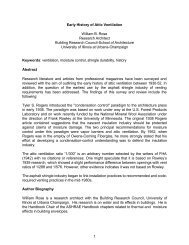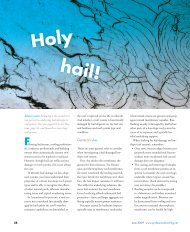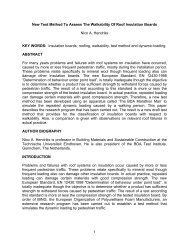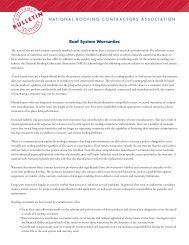Untitled - National Roofing Contractors Association
Untitled - National Roofing Contractors Association
Untitled - National Roofing Contractors Association
You also want an ePaper? Increase the reach of your titles
YUMPU automatically turns print PDFs into web optimized ePapers that Google loves.
to the roof membrane by other trades during this period<br />
is a major cause of roof problems. On gravel-surfaced<br />
roofs, damage is most difficult to discover and can remain<br />
undetected for years.<br />
The roofing contractor should make a final inspection<br />
of the roof, and, if he finds evidence of so-called "workbench"<br />
abuse, he should prepare a written report to the<br />
general contractor and/or owner of any visible damage<br />
found in the roof system. Where damage can be expected,<br />
the use of a temporary roof should be considered.<br />
(See Section III, Temporary Roofs.)<br />
xx. BITUMENS<br />
Asphalt and coal tar are the bitumens used for roofing<br />
purposes. They are versatile waterproofing materials<br />
whose properties are desirable for use in built-up roofing<br />
practice. They are thermoplastic, becoming more<br />
fluid with heat and reverting to a more solid material as<br />
they cool.<br />
<strong>Roofing</strong> bitumens are not the "glue" with which roofing<br />
felts are cemented together. Actually, the process is<br />
more of a "welding" or "fusion" process than a glueing<br />
process. The heated mopping bitumen melts and fuses<br />
with the saturant bitumen in the roofing felts, creating<br />
a "welding" together of the plies. Correct application<br />
temperatures are thus vital to the creation of a highoquality<br />
roof membrane system, and a high bitumen temperature<br />
must be maintained to create the welding process.<br />
The properties of bitumen are such that heating it at high<br />
temperatures for long periods of time may reduce the<br />
softening point of asphalt and raise the softening point<br />
of coal tar. The property of bitumen has produced the<br />
false impression that the temperatures ordinarily employed<br />
in bituminous heating are damaging to the material.<br />
In the past this impression has led to restrictive heating<br />
criteria. These restrictions have substantially contributed<br />
to poor roof installations.<br />
Bitumens can be heated at high temperatures for<br />
short periods of time without damage. In fact, they<br />
must be heated to high temperatures in order to achieve<br />
complete fusion and strong bonding of the plies.<br />
Temperature affects the viscosity, or flow, of the bitumen<br />
and, thus, the mopping weight. Temperatures that<br />
are too high (bitumen that has low viscosity and high<br />
flow) can lead to light moppings, incomplete film coverage,<br />
voids and a potential lack of waterproofing qualities.<br />
Temperatures that are too low (bitumen that has<br />
high viscosity and insufficient flow) can lead to heavy<br />
mappings, which result in poor adhesion, potential slippage<br />
problems, high expansion properties and low tensile<br />
strengths, which can contribute to roof splits. Obviously,<br />
there is an optimum viscosity range, and therefore,<br />
an optimum temperature range at the point of application<br />
for achieving complete fusion, optimum wetting<br />
and mopping properties, and which results in the<br />
desirable interply bitumen weight.<br />
In 1977, the <strong>National</strong> <strong>Roofing</strong> <strong>Contractors</strong> <strong>Association</strong><br />
(NRCA) adopted the Equiviscous Temperature (EVT)<br />
concept. This followed the determination that the flow<br />
characteristic (viscosity) of roofing bitumens at the point<br />
of application to the substrate is an important factor in<br />
the construction of built-up roof membranes. The<br />
Equiviscous Temperature (EVT) was then defined as<br />
the temperature at which the viscosity of roofing<br />
asphalt is 125 centistokes. A centistoke is a unit of a<br />
liquid's Kinematic Viscosity. It is obtained by dividing a<br />
liquid's dynamic viscosity expressed in centipoise by its<br />
density. Subsequently, NRCA redefined the Equiviscous<br />
Temperature (EVT) range of roofing asphalt as the temperature<br />
at which a viscosity of 125 centistokes is attained.<br />
plus or minus 25 F.<br />
The results of two recent research programs suggest an<br />
appropriate Equiviscous Temperature (EVT) for coal tar<br />
products and a need for modification of the Equiviscous<br />
Temperature (EVT) for roofing asphalt.<br />
NRCA recommends the following modifications in defining<br />
Equiviscous Temperatures (EVT) for roofing bitumens:<br />
32 33




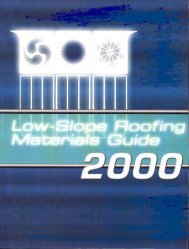
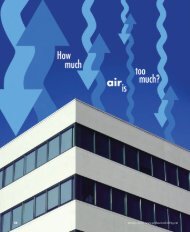

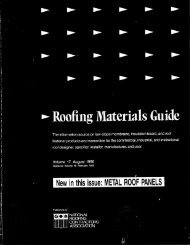
![Wm] - National Roofing Contractors Association](https://img.yumpu.com/36696816/1/190x245/wm-national-roofing-contractors-association.jpg?quality=85)


